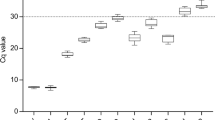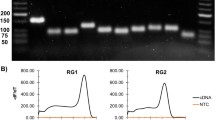Abstract
Eight putative consistently expressed genes in Carnobacterium maltaromaticum and Lactobacillus curvatus, and nine in Listeria innocua, were examined for their potential as references for the normalization of gene expression. Expression stability of candidate reference genes was evaluated under growth conditions of low (5 °C) and moderately high (40–42.5 °C) temperatures, and high salt (≥3 % NaCl) using the geNormplus and NormFinder algorithms. Under temperature stress, both algorithms ranked elongation factor Tu (Tuf) as the most stably expressed gene in C. maltaromaticum. In L. curvatus, at similar conditions, geNormplus identified Tuf and 6-phosphogluconate dehydrogenase (6PGDH) as suitable for normalization, while NormFinder identified phenylalanyl-tRNA synthase and recombinase A as the best pair. In L. innocua grown under the same temperatures, geNormplus ranked 6PGDH, glyceraldehyde-3-phosphate dehydrogenase (GAPDH), and Tuf as the top three most stable references, whereas NormFinder identified GAPDH and 6PGDH as suitable for normalization, with Tuf ranked as number six. There was less consistency between algorithms in the salt stress experiment. No gene was identified that exhibited such a constant level of expression as to outperform the other candidates under both experimental conditions. This study underlines the need for normalizing bacterial gene expression using multiple carefully selected references.








Similar content being viewed by others
References
Nolan, T., Hands, R. E., & Bustin, S. A. (2006). Quantification of mRNA using real-time RT-PCR. Nature Protocols, 1(3), 1559–1582.
VanGuilder, H. D., Vrana, K. E., & Freeman, W. M. (2008). Twenty-five years of quantitative PCR for gene expression analysis. Biotechniques, 44(5), 619–626.
Løvdal, T., & Lillo, C. (2009). Reference gene selection for quantitative real-time PCR normalization in tomato subjected to nitrogen, cold, and light stress. Analytical Biochemistry, 387(2), 238–242.
Thellin, O., Zorzi, W., Lakaye, B., De Borman, B., Coumans, B., Hennen, G., et al. (1999). Housekeeping genes as internal standards: Use and limits. Journal of Biotechnology, 75(2–3), 291–295.
Suzuki, T., Higgins, P. J., & Crawford, D. R. (2000). Control selection for RNA quantitation. Biotechniques, 29(2), 332–337.
Gutierrez, L., Mauriat, M., Guenin, S., Pelloux, J., Lefebvre, J. F., Louvet, R., et al. (2008). The lack of a systematic validation of reference genes: a serious pitfall undervalued in reverse transcription-polymerase chain reaction (RT-PCR) analysis in plants. Plant Biotechnology Journal, 6(6), 609–618.
Vandesompele, J., De Preter, K., Pattyn, F., Poppe, B., Van Roy, N., De Paepe, A., et al. (2002). Accurate normalization of real-time quantitative RT-PCR data by geometric averaging of multiple internal control genes. Genome Biology, 3(7), research0034.1–research0034.11.
Andersen, C. L., Jensen, J. L., & Orntoft, T. F. (2004). Normalization of real-time quantitative reverse transcription-PCR data: A model-based variance estimation approach to identify genes suited for normalization, applied to bladder and colon cancer data sets. Cancer Research, 64(15), 5245–5250.
Gutierrez, L., Mauriat, M., Pelloux, J., Bellini, C., & Van Wuytswinkel, O. (2008). Towards a systematic validation of references in real-time RT-PCR. Plant Cell, 20(7), 1734–1735.
Vandecasteele, S. J., Peetermans, W. E., Merckx, R., & Van Eldere, J. (2001). Quantification of expression of Staphylococcus epidermidis housekeeping genes with Taqman quantitative PCR during in vitro growth and under different conditions. Journal of Bacteriology, 183(24), 7094–7101.
Savli, H., Karadenizli, A., Kolayli, F., Gundes, S., Ozbek, U., & Vahaboglu, H. (2003). Expression stability of six housekeeping genes: a proposal for resistance gene quantification studies of Pseudomonas aeruginosa by real-time quantitative RT-PCR. Journal of Medical Microbiology, 52(5), 403–408.
Eleaume, H., & Jabbouri, S. (2004). Comparison of two standardisation methods in real-time quantitative RT-PCR to follow Staphylococcus aureus genes expression during in vitro growth. Journal of Microbiological Methods, 59(3), 363–370.
Takle, G. W., Toth, I. K., & Brurberg, M. B. (2007). Evaluation of reference genes for real-time RT-PCR expression studies in the plant pathogen Pectobacterium atrosepticum. BMC Plant Biology, 7(50). doi:10.1186/1471-2229-7-50.
Tasara, T., & Stephan, R. (2007). Evaluation of housekeeping genes in Listeria monocytogenes as potential internal control references for normalizing mRNA expression levels in stress adaptation models using real-time PCR. FEMS Microbiology Letters, 269(2), 265–272.
Theis, T., Skurray, R. A., & Brown, M. H. (2007). Identification of suitable internal controls to study expression of a Staphylococcus aureus multidrug resistance system by quantitative real-time PCR. Journal of Microbiological Methods, 70(2), 355–362.
Marco, M. L., & Kleerebezem, M. (2008). Assessment of real-time RT-PCR for quantification of Lactobacillus plantarum gene expression during stationary phase and nutrient starvation. Journal of Applied Microbiology, 104(2), 587–594.
Metcalf, D., Sharif, S., & Weese, J. S. (2010). Evaluation of candidate reference genes in Clostridium difficile for gene expression normalization. Anaerobe, 16(4), 439–443.
Reiter, L., Kolsto, A. B., & Piehler, A. P. (2011). Reference genes for quantitative, reverse-transcription PCR in Bacillus cereus group strains throughout the bacterial life cycle. Journal of Microbiological Methods, 86(2), 210–217.
Thomas, F., Barbeyron, T., & Michel, G. (2011). Evaluation of reference genes for real-time quantitative PCR in the marine flavobacterium Zobellia galactanivorans. Journal of Microbiological Methods, 84(1), 61–66.
Zhao, W., Li, Y., Gao, P., Sun, Z., Sun, T., & Zhang, H. (2011). Validation of reference genes for real-time quantitative PCR studies in gene expression levels of Lactobacillus casei Zhang. Journal of Industrial Microbiology and Biotechnology, 38(9), 1279–1286.
Leroi, F. (2010). Occurrence and role of lactic acid bacteria in seafood products. Food Microbiology, 27(6), 698–709.
Laursen, B. G., Bay, L., Cleenwerck, I., Vancanneyt, M., Swings, J., Dalgaard, P., et al. (2005). Carnobacterium divergens and Carnobacterium maltaromaticum as spoilers or protective cultures in meat and seafood: phenotypic and genotypic characterization. Systematic and Applied Microbiology, 28(2), 151–164.
Lyhs, U., & Björkroth, J. K. (2008). Lactobacillus sakei/curvatus is the prevailing lactic acid bacterium group in spoiled maatjes herring. Food Microbiology, 25(3), 529–533.
Blom, H., Katla, T., Nissen, H., & Ho, H. (2001). Characterization, production, and purification of carnocin H, a bacteriocin produced by Carnobacterium 377. Current Microbiology, 43(4), 227–231.
Cocolin, L., & Rantsiou, K. (2007). Sequencing and expression analysis of sakacin genes in Lactobacillus curvatus strains. Applied Microbiology and Biotechnology, 76(6), 1403–1411.
Hebert, E. M., Saavedra, L., Taranto, M. P., Mozzi, F., Magni, C., Nader, M. E. F., et al. (2012). Genome sequence of the bacteriocin-producing Lactobacillus curvatus strain CRL705. Journal of Bacteriology, 194(2), 538–539.
Fairchild, T. M., & Foegeding, P. M. (1993). A proposed nonpathogenic biological indicator for thermal inactivation of Listeria monocytogenes. Applied and Environmental Microbiology, 59(4), 1247–1250.
Kamat, A. S., & Nair, P. M. (1996). Identification of Listeria innocua as a biological indicator for inactivation of L. monocytogenes by some meat processing treatments. LWT-Food. Science and Technology, 29(8), 714–720.
Glaser, P., Frangeul, L., Buchrieser, C., Rusniok, C., Amend, A., Baquero, F., et al. (2001). Comparative genomics of Listeria species. Science, 294(5543), 849–852.
Schmid, M. W., Ng, E. Y. W., Lampidis, R., Emmerth, M., Walcher, M., Kreft, J., et al. (2005). Evolutionary history of the genus Listeria and its virulence genes. Systematic and Applied Microbiology, 28(1), 1–18.
Farber, J. M., & Peterkin, P. I. (1991). Listeria monocytogenes, a food-borne pathogen. Microbiology Reviews, 55(3), 476–511.
Gray, M. L., & Killinger, A. H. (1966). Listeria monocytogenes and listeric infections. Bacteriological Reviews, 30(2), 309–382.
Olesen, I., Vogensen, F. K., & Jespersen, L. (2009). Gene transcription and virulence potential of Listeria monocytogenes strains after exposure to acidic and NaCl stress. Foodborne Pathogens and Disease, 6(6), 669–680.
Olesen, I., Thorsen, L., & Jespersen, L. (2010). Relative transcription of Listeria monocytogenes virulence genes in liver pates with varying NaCl content. International Journal of Food Microbiology, 141, S60–S68.
Werbrouck, H., Vermeulen, A., Van Coillie, E., Messens, W., Herman, L., et al. (2009). Influence of acid stress on survival, expression of virulence genes and invasion capacity into Caco-2 cells of Listeria monocytogenes strains of different origins. International Journal of Food Microbiology, 134(1–2), 140–146.
Milohanic, E., Glaser, P., Coppee, J. Y., Frangeul, L., Vega, Y., et al. (2003). Transcriptome analysis of Listeria monocytogenes identifies three groups of genes differently regulated by PrfA. Molecular Microbiology, 47(6), 1613–1625.
D’Haene, B., Vandesompele, J., & Hellemans, J. (2010). Accurate and objective copy number profiling using real-time quantitative PCR. Methods, 50(4), 262–270.
Hellemans, J., Mortier, G., De Paepe, A., Speleman, F., & Vandesompele, J. (2007). qBase relative quantification framework and software for management and automated analysis of real-time quantitative PCR data. Genome Biology, 8(2). doi:10.1186/gb-2007-8-2-r19.
Anonymous, (2008). Real-time PCR: From theory to practice. Carlsbad: Invitrogen Corporation.
Bustin, S. A., Beaulieu, J.-F., Huggett, J., Jaggi, R., & Kibenge, F. S. B. (2010). MIQE précis: Practical implementation of minimum standard guidelines for fluorescence-based quantitative real-time PCR experiments. BMC Molecular Biology, 11(74). doi:10.1186/1471-2199-11-74.
Dykxhoorn, D. M., StPierre, R., & Linn, T. (1996). Synthesis of the beta and beta’ subunits of Escherichia coli RNA polymerase is autogenously regulated in vivo by both transcriptional and translational mechanisms. Molecular Microbiology, 19(3), 483–493.
Willems, E., Mateizel, I., Kemp, C., Cauffman, G., Sermon, K., & Leyns, L. (2006). Selection of reference genes in mouse embryos and in differentiating human and mouse ES cells. International Journal of Developmental Biology, 50(7), 627–635.
Leisner, J. J., Hansen, M. A., Larsen, M. H., Hansen, L., Ingmer, H., & Sorensen, S. J. (2012). The genome sequence of the lactic acid bacterium Carnobacterium maltaromaticum ATCC 35586 encodes potential virulence factors. International Journal of Food Microbiology, 152(3), 107–115.
Acknowledgments
The authors would like to express thanks to Kathrine Sundvor (Intertek West Lab., Tananger) and Karin S. Tranøy (Nofima AS, Stavanger) for technical assistance. This study was financially supported by the foundation NORCONSERV through project LABLiPS.
Author information
Authors and Affiliations
Corresponding author
Electronic supplementary material
Below is the link to the electronic supplementary material.




Rights and permissions
About this article
Cite this article
Løvdal, T., Saha, A. Reference Gene Selection in Carnobacterium maltaromaticum, Lactobacillus curvatus, and Listeria innocua Subjected to Temperature and Salt Stress. Mol Biotechnol 56, 210–222 (2014). https://doi.org/10.1007/s12033-013-9697-x
Published:
Issue Date:
DOI: https://doi.org/10.1007/s12033-013-9697-x




